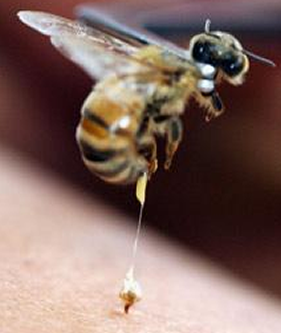Life-threatening, bee-related situations are rare, but they do occur. Some situations require immediate response, while others are less serious.
There is a danger from sting venom. Honey bees are beneficial when they pollinate our fruits and vegetables. Most people have a normal reaction of localized discomfort when stung, but in some situations, bee stings may cause more serious abnormal or systemic reactions. They cause problems that are life-threatening. People can die from sting venom due to an allergic reaction (only one or two stings) or a toxic reaction from numerous stings (about 1,000 or more)
A normal reaction to a sting is localized, with swelling, redness and pain occurring near the sting site. Some people swell more than others. A sting on the wrist may cause the arm to swell up to the elbow. Some people show a delayed reaction, with symptoms appearing one to several hours later.
Allergic reactions occur only in 5 percent of the population and may have life-threatening allergic reaction to venom. These persons can go into anaphylactic shock and die from one or two stings unless treated immediately. Many people do not know they are allergic.
Generally what you need to do for a sting is remove the stinger. The honey bee stinger penetrates the skin and embeds itself because the sting shaft is barbed. The poison sack and attached muscles continue to pump venom into the skin after the bee has departed. The sting and poison sack should be removed by scraping with a thumbnail or other straight-edge as soon as possible to reduce the amount of venom being injected. Do not use tweezers because pressure on the poison sack release more poison into the victim
.

- Safety first! Get away from the bee. Bees release a scent when in danger to attract other bees. If you're still around when reinforcements get there, they'll sting you.
- Follow universal precautions and wear personal protective equipment if you have it.
- Remove any stingers immediately! No need to scrape off bee stingers, just remove them. It's OK to pull stingers out with your fingers. The longer bee stingers are allowed to remain in the body, the more severe the reaction will be.
- If the victim is allergic to bees, check to see if the victim is carrying an epinephrine auto-injector (EpiPen). If so, help the victim use the EpiPen. If the victim is supposed to carry an EpiPen and does not have it, call 911 immediately! Do not wait for symptoms to appear.
Watch any victim closely for signs of anaphylaxis.- itching
- redness
- hives (raised welts)
- shortness of breath
- If there is any concern that the victim may be developing anaphylaxis, call 911 immediately. Antihistamines, such as diphenhydramine (Benedryl), can slow an anaphylactic reaction, but will not stop it.
- Non-allergic victims will almost always develop local reactions to bee stings. Redness, swelling, and pain are all common at the site of the bee sting. The pain will usually go away pretty quickly, but swelling may last for more than a day. Use an ice pack to reduce swelling at the site.
- It's common to develop some itching at the bee sting site. Antihistamines or calamine lotion should help.
- Take the victim to the emergency department if the victim was stung more than 10 times, or if there are bee stings inside the nose, mouth, or throat. Swelling from these stings can cause shortness of breath, even in non-allergic victims.
- Use ibuprofen or acetaminophen for minor pain relief. For tenderness at the site, try a bee-sting to dull the pain.
Tips:
- Conventional wisdom says to scrape bee stingers away from the skin because pinching the venom sack could push extra venom into the victim. In fact, how fast you get the stinger out is much more important than how.
- Honey bees leave a stinger behind when they sting a victim. Wasps, yellow jackets, and hornets do not leave a stinger. These relatives of the honey bee can also cause an anaphylactic reaction..